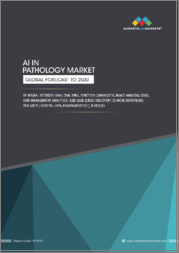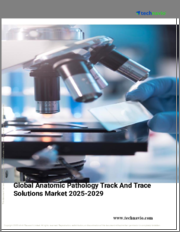
|
시장보고서
상품코드
1691745
해부 병리학 시장 - 세계 산업 규모, 점유율, 동향, 기회, 예측, 유형별, 기술별, 용도별, 최종사용자별, 지역별 부문, 경쟁(2020-2030년)Anatomic Pathology Market - Global Industry Size, Share, Trends, Opportunity, and Forecast, Segmented By Type, By Technique, By Application, By End-User By Region & Competition, 2020-2030F |
||||||
해부 병리학 세계 시장 규모는 2024년 360억 9,000만 달러로 평가되었으며, 2030년까지 연평균 복합 성장률(CAGR) 7.90%로 견조한 성장이 예상됩니다.
해부 병리학 세계 시장은 현미경으로 조직과 세포를 검사하여 질병을 진단하고 질병을 규명하는 헬스케어 산업에서 역동적이고 중요한 분야입니다. 이 시장에는 임상 검사, 진단 기기, 관련 소모품 등 다양한 제품과 서비스가 포함됩니다.
| 시장 개요 | |
|---|---|
| 예측 기간 | 2026-2030년 |
| 시장 규모 : 2024년 | 360억 9,000만 달러 |
| 시장 규모 : 2030년 | 565억 달러 |
| CAGR : 2025-2030년 | 7.90% |
| 급성장 부문 | 신약 및 의약품 개발 |
| 최대 시장 | 북미 |
시장 성장 촉진요인
만성질환 및 암 발생률 증가
주요 시장 이슈
상환 문제
주요 시장 동향
디지털 병리학의 급속한 발전
목차
제1장 개요
제2장 조사 방법
제3장 주요 요약
제4장 세계의 해부 병리학 시장 전망
- 시장 규모와 예측
- 금액별
- 시장 점유율과 예측
- 유형별(조직 병리학, 세포 병리학, 외과 병리학, 기타)
- 기술별(특수 염색, 면역조직화학, 전자현미경 검사, 유전자 검사, 기타)
- 용도별(질환 진단, 신약 발견, 개발)
- 최종사용자별(병원, 연구기관, 진단 기관, 기타)
- 지역별
- 기업별(2024년)
- 시장 맵
- 유형별
- 기술별
- 용도별
- 최종사용자별
- 지역별
제5장 아시아태평양의 해부 병리학 시장 전망
- 시장 규모와 예측
- 금액별
- 시장 점유율과 예측
- 유형별
- 기술별
- 용도별
- 최종사용자별
- 국가별
- 아시아태평양 : 국가별 분석
- 중국
- 인도
- 호주
- 일본
- 한국
제6장 유럽의 해부 병리학 시장 전망
- 시장 규모와 예측
- 시장 점유율과 예측
- 유럽 : 국가별 분석
- 독일
- 스페인
- 이탈리아
- 영국
제7장 북미의 해부 병리학 시장 전망
- 시장 규모와 예측
- 시장 점유율과 예측
- 북미 : 국가별 분석
- 멕시코
- 캐나다
제8장 남미의 해부 병리학 시장 전망
- 시장 규모와 예측
- 시장 점유율과 예측
- 남미 : 국가별 분석
- 아르헨티나
- 콜롬비아
제9장 중동 및 아프리카의 해부 병리학 시장 전망
- 시장 규모와 예측
- 시장 점유율과 예측
- 중동 및 아프리카 : 국가별 분석
- 사우디아라비아
- 아랍에미리트(UAE)
제10장 시장 역학
- 성장 촉진요인
- 과제
제11장 시장 동향과 발전
- 최근 동향
- 제품 출시
- 인수합병(M&A)
제12장 세계의 해부 병리학 시장 : SWOT 분석
제13장 Porter의 Five Forces 분석
- 업계내 경쟁
- 신규 참여 가능성
- 공급업체의 힘
- 고객의 힘
- 대체품의 위협
제14장 경쟁 구도
- Quest Diagnostics Inc
- Danaher Corporation
- PHC Holdings Corporation
- Laboratory Corporation of America Holdings
- F. Hoffmann-La Roche AG
- Agilent Technologies Inc.
- Cardinal Health Inc.
- Sakura Finetek USA Inc.
- NeoGenomics Laboratories Inc.
- BioGenex.
제15장 전략적 제안
제16장 리서치사에 대해 & 면책사항
LSH 25.04.15Global Anatomic Pathology Market was valued at USD 36.09 billion in 2024 and is anticipated to project robust growth in the forecast period with a CAGR of 7.90% through 2030. The Global Anatomic Pathology Market is a dynamic and vital sector within the healthcare industry, dedicated to the diagnosis and understanding of diseases through the examination of tissues and cells at a microscopic level. This market encompasses a wide range of products and services, including laboratory testing, diagnostic equipment, and related consumables.
| Market Overview | |
|---|---|
| Forecast Period | 2026-2030 |
| Market Size 2024 | USD 36.09 Billion |
| Market Size 2030 | USD 56.50 Billion |
| CAGR 2025-2030 | 7.90% |
| Fastest Growing Segment | Drug Discovery and development |
| Largest Market | North America |
Key Market Drivers
Rising Incidence of Chronic Diseases and Cancer
The Global Anatomic Pathology Market is experiencing a notable boost due to the rising incidence of chronic diseases and cancer worldwide. This epidemiological trend has become a significant driver in the expansion of the anatomic pathology sector. For instance, The World Health Organization (WHO) estimates that in 2022, there were 20 million new cancer cases and 9.7 million cancer-related deaths worldwide. Around 53.5 million individuals were expected to survive at least five years after their initial cancer diagnosis, highlighting the ongoing global burden of the disease and the need for continued advancements in cancer detection, treatment, and survivorship care. Chronic diseases, including cardiovascular diseases, diabetes, and respiratory conditions, have been steadily increasing in prevalence, primarily attributed to factors such as aging populations, sedentary lifestyles, and poor dietary choices. Similarly, cancer, one of the most formidable health challenges, continues to grow in frequency, impacting millions of lives globally.
Anatomic pathology plays an indispensable role in the diagnosis and characterization of these diseases. Pathologists examine tissue and cell samples at a microscopic level, providing critical insights into disease progression, staging, and treatment planning. In the context of cancer, precise and timely pathological analysis is essential for determining the type of cancer, its aggressiveness, and the presence of specific biomarkers. This information guides oncologists in developing personalized treatment strategies, such as targeted therapies and immunotherapies, ultimately improving patient outcomes.
As the global healthcare landscape grapples with the increasing burden of chronic diseases and cancer, the demand for anatomic pathology services continues to surge. This heightened demand is not only driven by the sheer volume of cases but also by the need for accurate and comprehensive diagnostic information. Patients and healthcare providers alike are recognizing the pivotal role that anatomic pathology plays in delivering effective and personalized care. The integration of technology, such as digital pathology and molecular diagnostics, into anatomic pathology practices has enhanced the precision and efficiency of disease diagnosis. Digital pathology enables the remote viewing and analysis of pathology slides, facilitating consultations and second opinions from experts around the world. Molecular pathology techniques allow for the examination of genetic and molecular alterations within tissues, guiding the development of targeted therapies and immunotherapies.
Key Market Challenges
Reimbursement Issues
One of the primary concerns in the anatomic pathology market is the uncertainty surrounding reimbursement rates. Pathology services encompass a wide range of diagnostic tests, including histopathology, cytology, and molecular diagnostics, which often involve the use of sophisticated technologies and equipment. However, reimbursement rates for these services may not always reflect the true cost incurred by laboratories, particularly in cases where advanced diagnostic techniques are employed. This disparity between the cost of providing services and the reimbursement received can strain the financial viability of pathology laboratories, hampering their ability to invest in state-of-the-art equipment and technologies.
The complexity of reimbursement systems and the variation in policies across different regions can further compound the challenges. Navigating the intricacies of billing, coding, and documentation requirements can be time-consuming and resource-intensive for pathology laboratories. This administrative burden not only adds overhead costs but can also lead to delays in reimbursement, affecting the cash flow of these facilities.
The impact of reimbursement issues extends beyond pathology laboratories; it can also influence patient access to advanced diagnostic services. When laboratories are constrained by inadequate reimbursement rates, they may be reluctant to offer certain tests or invest in the latest technologies.
Key Market Trends
Rapid Advancements in Digital Pathology
Rapid advancements in digital pathology are serving as a driving force behind the burgeoning Global Anatomic Pathology Market. Digital pathology, a transformative technology, involves the digitization of traditional glass pathology slides and the analysis of tissue specimens in a digital format. This innovation has been a game-changer in the field of anatomic pathology, bringing a multitude of benefits that are accelerating its growth and adoption worldwide.
One of the most significant contributions of digital pathology is its ability to improve the accuracy and efficiency of diagnostic processes. By converting glass slides into high-resolution digital images, pathologists can access and analyze tissue specimens remotely. This enables the seamless sharing of pathology slides across geographical boundaries, facilitating consultations with experts from different parts of the world. The collaborative nature of digital pathology not only enhances the quality of diagnostic decisions but also expedites patient care.
Artificial intelligence (AI) and machine learning are increasingly integrated into digital pathology platforms, opening new horizons for automation and diagnostic assistance. AI algorithms can assist pathologists in identifying abnormalities, quantifying biomarkers, and streamlining workflow processes. This trend is reducing the risk of human error, accelerating the pace of diagnosis, and ultimately improving patient outcomes. AI-driven image analysis is enabling the identification of subtle morphological patterns and molecular markers that may be challenging to detect through traditional methods.
The digital pathology is enabling the creation of vast digital archives of pathology data. These digital repositories allow for the retrospective analysis of pathology cases, which can lead to the discovery of new insights into disease progression and treatment outcomes. Researchers can harness this wealth of data to conduct retrospective studies and advance our understanding of various diseases, ultimately contributing to the development of more effective therapies.
Key Market Players
- Quest Diagnostics Inc
- Danaher Corporation
- PHC Holdings Corporation
- Laboratory Corporation of America Holdings
- F. Hoffmann-La Roche AG
- Agilent Technologies Inc.
- Cardinal Health Inc.
- Sakura Finetek USA Inc.
- NeoGenomics Laboratories Inc.
- BioGenex
Report Scope:
In this report, the Global Anatomic Pathology Market has been segmented into the following categories, in addition to the industry trends which have also been detailed below:
Anatomic Pathology Market, By Type:
- Histopathology
- Cytopathology
- Surgical Pathology
- Others
Anatomic Pathology Market, By Technique:
- Special Staining
- Immunohistochemistry
- Electron Microscopy
- Genetic Testing
- Others
Anatomic Pathology Market, By Application:
- Disease Diagnosis
- Drug Discovery and Development
Anatomic Pathology Market, By End-User:
- Hospitals
- Research Laboratories
- Diagnostic Laboratories
- Others
Anatomic Pathology Market, By Region:
- North America
- United States
- Canada
- Mexico
- Europe
- France
- United Kingdom
- Italy
- Germany
- Spain
- Asia-Pacific
- China
- India
- Japan
- Australia
- South Korea
- South America
- Brazil
- Argentina
- Colombia
- Middle East & Africa
- South Africa
- Saudi Arabia
- UAE
Competitive Landscape
Company Profiles: Detailed analysis of the major companies present in the Global Anatomic Pathology Market.
Available Customizations:
Global Anatomic Pathology Market report with the given market data, TechSci Research offers customizations according to a company's specific needs. The following customization options are available for the report:
Company Information
- Detailed analysis and profiling of additional market players (up to five).
Table of Contents
1. Product Overview
- 1.1. Market Definition
- 1.2. Scope of the Market
- 1.2.1. Markets Covered
- 1.2.2. Years Considered for Study
- 1.2.3. Key Market Segmentations
2. Research Methodology
- 2.1. Objective of the Study
- 2.2. Baseline Methodology
- 2.3. Key Industry Partners
- 2.4. Major Association and Secondary Sources
- 2.5. Forecasting Methodology
- 2.6. Data Triangulation & Validation
- 2.7. Assumptions and Limitations
3. Executive Summary
- 3.1. Overview of the Market
- 3.2. Overview of Key Market Segmentations
- 3.3. Overview of Key Market Players
- 3.4. Overview of Key Regions/Countries
- 3.5. Overview of Market Drivers, Challenges, Trends
4. Global Anatomic Pathology Market Outlook
- 4.1. Market Size & Forecast
- 4.1.1. By Value
- 4.2. Market Share & Forecast
- 4.2.1. By Type (Histopathology, Cytopathology, Surgical Pathology, Others)
- 4.2.2. By Technique (Special Staining, Immunohistochemistry, Electron Microscopy, Genetic Testing, Others)
- 4.2.3. By Application (Disease Diagnosis, Drug Discovery and Development)
- 4.2.4. By End-User (Hospitals, Research Laboratories, Diagnostic Laboratories, Others)
- 4.2.5. By Region
- 4.2.6. By Company (2024)
- 4.3. Market Map
- 4.3.1. By Type
- 4.3.2. By Technique
- 4.3.3. By Application
- 4.3.4. By End-User
- 4.3.5. By Region
5. Asia Pacific Anatomic Pathology Market Outlook
- 5.1. Market Size & Forecast
- 5.1.1. By Value
- 5.2. Market Share & Forecast
- 5.2.1. By Type
- 5.2.2. By Technique
- 5.2.3. By Application
- 5.2.4. By End-User
- 5.2.5. By Country
- 5.3. Asia Pacific: Country Analysis
- 5.3.1. China Anatomic Pathology Market Outlook
- 5.3.1.1. Market Size & Forecast
- 5.3.1.1.1. By Value
- 5.3.1.2. Market Share & Forecast
- 5.3.1.2.1. By Type
- 5.3.1.2.2. By Technique
- 5.3.1.2.3. By Application
- 5.3.1.2.4. By End-User
- 5.3.1.1. Market Size & Forecast
- 5.3.2. India Anatomic Pathology Market Outlook
- 5.3.2.1. Market Size & Forecast
- 5.3.2.1.1. By Value
- 5.3.2.2. Market Share & Forecast
- 5.3.2.2.1. By Type
- 5.3.2.2.2. By Technique
- 5.3.2.2.3. By Application
- 5.3.2.2.4. By End-User
- 5.3.2.1. Market Size & Forecast
- 5.3.3. Australia Anatomic Pathology Market Outlook
- 5.3.3.1. Market Size & Forecast
- 5.3.3.1.1. By Value
- 5.3.3.2. Market Share & Forecast
- 5.3.3.2.1. By Type
- 5.3.3.2.2. By Technique
- 5.3.3.2.3. By Application
- 5.3.3.2.4. By End-User
- 5.3.3.1. Market Size & Forecast
- 5.3.4. Japan Anatomic Pathology Market Outlook
- 5.3.4.1. Market Size & Forecast
- 5.3.4.1.1. By Value
- 5.3.4.2. Market Share & Forecast
- 5.3.4.2.1. By Type
- 5.3.4.2.2. By Technique
- 5.3.4.2.3. By Application
- 5.3.4.2.4. By End-User
- 5.3.4.1. Market Size & Forecast
- 5.3.5. South Korea Anatomic Pathology Market Outlook
- 5.3.5.1. Market Size & Forecast
- 5.3.5.1.1. By Value
- 5.3.5.2. Market Share & Forecast
- 5.3.5.2.1. By Type
- 5.3.5.2.2. By Technique
- 5.3.5.2.3. By Application
- 5.3.5.2.4. By End-User
- 5.3.5.1. Market Size & Forecast
- 5.3.1. China Anatomic Pathology Market Outlook
6. Europe Anatomic Pathology Market Outlook
- 6.1. Market Size & Forecast
- 6.1.1. By Value
- 6.2. Market Share & Forecast
- 6.2.1. By Type
- 6.2.2. By Technique
- 6.2.3. By Application
- 6.2.4. By End-User
- 6.2.5. By Country
- 6.3. Europe: Country Analysis
- 6.3.1. France Anatomic Pathology Market Outlook
- 6.3.1.1. Market Size & Forecast
- 6.3.1.1.1. By Value
- 6.3.1.2. Market Share & Forecast
- 6.3.1.2.1. By Type
- 6.3.1.2.2. By Technique
- 6.3.1.2.3. By Application
- 6.3.1.2.4. By End-User
- 6.3.1.1. Market Size & Forecast
- 6.3.2. Germany Anatomic Pathology Market Outlook
- 6.3.2.1. Market Size & Forecast
- 6.3.2.1.1. By Value
- 6.3.2.2. Market Share & Forecast
- 6.3.2.2.1. By Type
- 6.3.2.2.2. By Technique
- 6.3.2.2.3. By Application
- 6.3.2.2.4. By End-User
- 6.3.2.1. Market Size & Forecast
- 6.3.3. Spain Anatomic Pathology Market Outlook
- 6.3.3.1. Market Size & Forecast
- 6.3.3.1.1. By Value
- 6.3.3.2. Market Share & Forecast
- 6.3.3.2.1. By Type
- 6.3.3.2.2. By Technique
- 6.3.3.2.3. By Application
- 6.3.3.2.4. By End-User
- 6.3.3.1. Market Size & Forecast
- 6.3.4. Italy Anatomic Pathology Market Outlook
- 6.3.4.1. Market Size & Forecast
- 6.3.4.1.1. By Value
- 6.3.4.2. Market Share & Forecast
- 6.3.4.2.1. By Type
- 6.3.4.2.2. By Technique
- 6.3.4.2.3. By Application
- 6.3.4.2.4. By End-User
- 6.3.4.1. Market Size & Forecast
- 6.3.5. United Kingdom Anatomic Pathology Market Outlook
- 6.3.5.1. Market Size & Forecast
- 6.3.5.1.1. By Value
- 6.3.5.2. Market Share & Forecast
- 6.3.5.2.1. By Type
- 6.3.5.2.2. By Technique
- 6.3.5.2.3. By Application
- 6.3.5.2.4. By End-User
- 6.3.5.1. Market Size & Forecast
- 6.3.1. France Anatomic Pathology Market Outlook
7. North America Anatomic Pathology Market Outlook
- 7.1. Market Size & Forecast
- 7.1.1. By Value
- 7.2. Market Share & Forecast
- 7.2.1. By Type
- 7.2.2. By Technique
- 7.2.3. By End-User
- 7.2.4. By Application
- 7.2.5. By Country
- 7.3. North America: Country Analysis
- 7.3.1. United States Anatomic Pathology Market Outlook
- 7.3.1.1. Market Size & Forecast
- 7.3.1.1.1. By Value
- 7.3.1.2. Market Share & Forecast
- 7.3.1.2.1. By Type
- 7.3.1.2.2. By Technique
- 7.3.1.2.3. By Application
- 7.3.1.2.4. By End-User
- 7.3.1.1. Market Size & Forecast
- 7.3.2. Mexico Anatomic Pathology Market Outlook
- 7.3.2.1. Market Size & Forecast
- 7.3.2.1.1. By Value
- 7.3.2.2. Market Share & Forecast
- 7.3.2.2.1. By Type
- 7.3.2.2.2. By Technique
- 7.3.2.2.3. By Application
- 7.3.2.2.4. By End-User
- 7.3.2.1. Market Size & Forecast
- 7.3.3. Canada Anatomic Pathology Market Outlook
- 7.3.3.1. Market Size & Forecast
- 7.3.3.1.1. By Value
- 7.3.3.2. Market Share & Forecast
- 7.3.3.2.1. By Type
- 7.3.3.2.2. By Technique
- 7.3.3.2.3. By Application
- 7.3.3.2.4. By End-User
- 7.3.3.1. Market Size & Forecast
- 7.3.1. United States Anatomic Pathology Market Outlook
8. South America Anatomic Pathology Market Outlook
- 8.1. Market Size & Forecast
- 8.1.1. By Value
- 8.2. Market Share & Forecast
- 8.2.1. By Type
- 8.2.2. By Technique
- 8.2.3. By End-User
- 8.2.4. By Application
- 8.2.5. By Country
- 8.3. South America: Country Analysis
- 8.3.1. Brazil Anatomic Pathology Market Outlook
- 8.3.1.1. Market Size & Forecast
- 8.3.1.1.1. By Value
- 8.3.1.2. Market Share & Forecast
- 8.3.1.2.1. By Type
- 8.3.1.2.2. By Technique
- 8.3.1.2.3. By Application
- 8.3.1.2.4. By End-User
- 8.3.1.1. Market Size & Forecast
- 8.3.2. Argentina Anatomic Pathology Market Outlook
- 8.3.2.1. Market Size & Forecast
- 8.3.2.1.1. By Value
- 8.3.2.2. Market Share & Forecast
- 8.3.2.2.1. By Type
- 8.3.2.2.2. By Technique
- 8.3.2.2.3. By Application
- 8.3.2.2.4. By End-User
- 8.3.2.1. Market Size & Forecast
- 8.3.3. Colombia Anatomic Pathology Market Outlook
- 8.3.3.1. Market Size & Forecast
- 8.3.3.1.1. By Value
- 8.3.3.2. Market Share & Forecast
- 8.3.3.2.1. By Type
- 8.3.3.2.2. By Technique
- 8.3.3.2.3. By Application
- 8.3.3.2.4. By End-User
- 8.3.3.1. Market Size & Forecast
- 8.3.1. Brazil Anatomic Pathology Market Outlook
9. Middle East and Africa Anatomic Pathology Market Outlook
- 9.1. Market Size & Forecast
- 9.1.1. By Value
- 9.2. Market Share & Forecast
- 9.2.1. By Type
- 9.2.2. By Technique
- 9.2.3. By Application
- 9.2.4. By End-User
- 9.2.5. By Country
- 9.3. MEA: Country Analysis
- 9.3.1. South Africa Anatomic Pathology Market Outlook
- 9.3.1.1. Market Size & Forecast
- 9.3.1.1.1. By Value
- 9.3.1.2. Market Share & Forecast
- 9.3.1.2.1. By Type
- 9.3.1.2.2. By Technique
- 9.3.1.2.3. By Application
- 9.3.1.2.4. By End-User
- 9.3.1.1. Market Size & Forecast
- 9.3.2. Saudi Arabia Anatomic Pathology Market Outlook
- 9.3.2.1. Market Size & Forecast
- 9.3.2.1.1. By Value
- 9.3.2.2. Market Share & Forecast
- 9.3.2.2.1. By Type
- 9.3.2.2.2. By Technique
- 9.3.2.2.3. By Application
- 9.3.2.2.4. By End-User
- 9.3.2.1. Market Size & Forecast
- 9.3.3. UAE Anatomic Pathology Market Outlook
- 9.3.3.1. Market Size & Forecast
- 9.3.3.1.1. By Value
- 9.3.3.2. Market Share & Forecast
- 9.3.3.2.1. By Type
- 9.3.3.2.2. By Technique
- 9.3.3.2.3. By Application
- 9.3.3.2.4. By End-User
- 9.3.3.1. Market Size & Forecast
- 9.3.1. South Africa Anatomic Pathology Market Outlook
10. Market Dynamics
- 10.1. Drivers
- 10.2. Challenges
11. Market Trends & Developments
- 11.1. Recent Developments
- 11.2. Product Launches
- 11.3. Mergers & Acquisitions
12. Global Anatomic Pathology Market: SWOT Analysis
13. Porter's Five Forces Analysis
- 13.1. Competition in the Industry
- 13.2. Potential of New Entrants
- 13.3. Power of Suppliers
- 13.4. Power of Customers
- 13.5. Threat of Substitute Product
14. Competitive Landscape
- 14.1. Quest Diagnostics Inc
- 14.1.1. Business Overview
- 14.1.2. Company Snapshot
- 14.1.3. Products & Services
- 14.1.4. Current Capacity Analysis
- 14.1.5. Financials (In case of listed)
- 14.1.6. Recent Developments
- 14.1.7. SWOT Analysis
- 14.2. Danaher Corporation
- 14.3. PHC Holdings Corporation
- 14.4. Laboratory Corporation of America Holdings
- 14.5. F. Hoffmann-La Roche AG
- 14.6. Agilent Technologies Inc.
- 14.7. Cardinal Health Inc.
- 14.8. Sakura Finetek USA Inc.
- 14.9. NeoGenomics Laboratories Inc.
- 14.10.BioGenex.
15. Strategic Recommendations
16. About Us & Disclaimer
(주말 및 공휴일 제외)


















